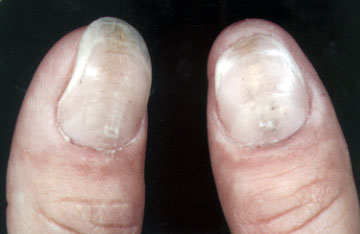
Am Fam Physician. 1998;58(7):1647-1648
A 47-year-old woman presented to the office with an “ugly” thumbnail on her right hand that she had had for more than a decade. After she began a more challenging job two years ago, the thumbnail on her left hand began to show similar changes (see the accompanying photograph). The index finger on her right hand was also becoming affected. She reported no other medical problems and had tried over-the-counter miconazole cream (Monistat) without benefit. Another physician had previously prescribed terbinafine (Lamisil), at 125 mg daily for three months; however, there was no change in the appearance of the nail.

Question
Discussion
The answer is D: behavior modification. This patient has a habit-tic deformity, a relatively common nail disorder that is often confused with onychomycosis. It is caused by the conscious or unconscious rubbing and picking of the proximal nail fold and cuticle area. Habit-tic deformity is most often found on the thumb of the dominant hand, which is being rubbed by the index or middle finger of that same hand. Other fingers may become involved, especially during times of stress. Diagnostic clues in this case include a normal medical history, irregularly spaced horizontal grooves in the mid-nail plate, the lichenification (skin thickening) of the nail fold and focal loss of the cuticle.1 The rubbing and picking damage the nail matrix, which lies proximal to the cuticle, producing an abnormal nail plate. The only reasonable differential diagnosis for this condition would be median nail dystrophy. This disorder is characterized by a central ridge or tube running longitudinally in the nail plate, resulting in regular radiating ridges in a Christmas tree–like pattern.
While habit-tic deformity is considered to be a compulsive disorder, and medications such as selective serotonin reuptake inhibitors have some theoretic use, a much simpler approach with fewer side effects may be even more effective. The patient could apply tape over the mid-nail fold and cuticle area during waking hours. The tape serves as a constant reminder to the patient and an interruption to the habitual trauma. There is nothing that can be done to “repair” the already damaged nail plate, but the patient will see results in two to three weeks as the nail matrix quickly recovers and produces a normal nail.